Introduction
This low-cost, 30’ long by 18’ wide PVC high tunnel is constructed using PVC pipe for hoops. The materials cost roughly $500 (including shade cloth for summer production) and we didn’t shop for the best buy on materials and lumber. A slight disadvantage of the design is that curvature of the hoops may allow rain to run inside the edge of the house when the sides are raised for ventilation.
Download Construction for 12ft x 40ft Hoop HouseOne person can complete most of the construction, but inserting the hoops and putting on the plastic requires at least two people. Also, it is nice to have someone to share the heavy work of driving in the ground posts. A crew of four can easily construct a high tunnel of this design in a single day.
The dimensions of this high tunnel design may be scaled-down if you have limited space available for your high tunnel. At a lesser diameter, or in well-protected locations, it may be possible to use 1” PVC for the hoops, with 1½” PVC for the posts. The length of pipe to use for hoops may be calculated using the formula for the circumference of a circle, (3.14)r, where r is half the width of your tunnel. Add 3’ to insert into the ground posts.
PVC will react with the polyethylene greenhouse covering, so in order to attain the expected 4-year life span of the plastic, measures should be taken to prevent contact between the PVC and the polyethylene covering. This may be done by painting or taping the side of the PVC hoops that will be in contact with the plastic. Having said that, the oldest high tunnel at Bear Creek Farm in Osceola, Missouri, is eight years old and is still covered by its original plastic, which is in contact with the PVC hoops.
Note: Our procedure calls for driving 3’-long PVC posts into the ground after laying out the baseboards. We have found this to be a convenient way to proceed. However, in shallow, tight or stony soils, it may be necessary to dig holes using an augur, and then set the posts in concrete. If it is likely that you will need to do this, then posts should be set before laying out the baseboards.

Figure 1. Baseboards laid-out ready for ground post installation.

Figure 2. Ground posts ready to be driven in.
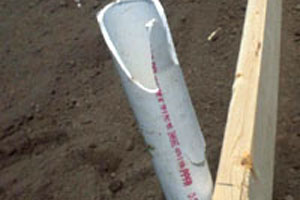
Figure 3. Ground posts damaged during pounding. This can be prevented by pounding on a 2″x4″ rather then directly on the PVC pipe.
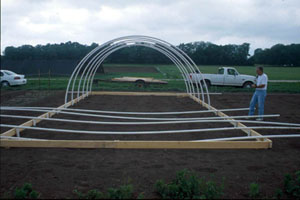
Figure 4. Hoops being placed in ground posts.

Figure 5. Drilling through baseboard, ground post and hoop. Carriage bolts will hold hoop in place.
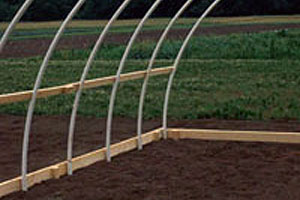
Figure 6. Tunnel with purlin and hip board in place.
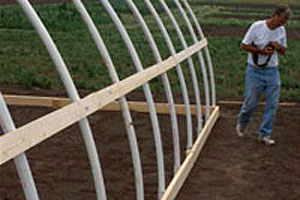
Figure 7. Hip board in place
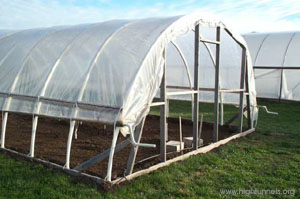
Figure 8. Tunnel showing end wall design at K-State Research and Extension Center, Olathe, Kansas.
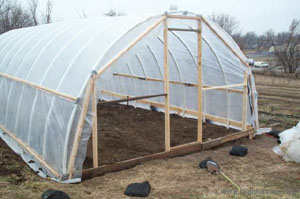
Figure 9. Tunnel showing end wall design at Full Circle Farm, Kansas City, Kansas.
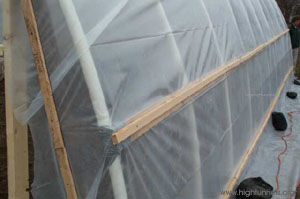
Figure 10. Poly attachment to hip board using one furring strip. This method is less secure than others since poly tends to tear at the screws.
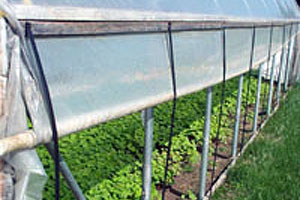
Figure 11. Picture showing the 2-furring strip method of attaching poly to the hip board.

Figure 12. Poly attachment to hip board using wiggle wire.
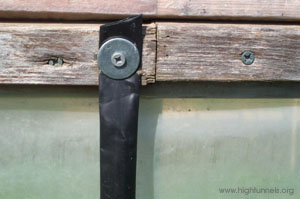
Figure 13. A drip tape strip from hip board to base board at each hoop can keep side walls from billowing.
Materials
| Material | Dimension | Quantity | Notes |
| Twine & Pegs | For corner and baseboard layout. | ||
| Lumber | 2″ x 6″ x 10’ | 6 | For baseboards. The boards will be in contact with the soil, so you might consider a rot resistant wood, such as cedar or redwood. If you will be growing food crops in the tunnel, it’s probably best not to use treated lumber because of possible health concerns. |
| 1″ x 4″ x 10’ | 6 | For hip boards. | |
| 2” x 4” x 8′ | 18 | Lumber for attaching baseboards, bracing end hoop, and framing end-walls. | |
| 2” x 4” x 10′ | 4 | Lumber for framing doors. Depending on door size, amount of bracing desired amount may vary. We put a 32”-wide door on each end. | |
| Furring strips | 1″ x 2″ x 10’ | 12 | For attaching plastic to hip boards and end-walls. Poly tape may also be used for attaching plastic to end walls. Wiggle wire is a more costly but convenient method for attaching plastic to hip boards. |
| Schedule 40 PVC pipe | 1½” x 20’ bell-end | 12 | For 11 hoops + purlin. |
| 10’ x 1½”straight-end | 12 | For 11 hoops + purlin. | |
| 3’ pieces of 2” | 22 | For ground posts. Requires 8 10′ pieces | |
| Primer & Glue | For connecting PVC pipe | ||
| Carriage bolts | 4½” x ¼” | 33 | For attaching hoops and posts to baseboards, and hoops to purlin – purchase bolts, washers and nuts. |
| Deck screws | 1½” | 1 lb | |
| 2½” | 2 lb | ||
| 3½” | 2 lb | ||
| Chain link fence top rail | 31′ | 2 | For roll up sides. |
| PVC fittings | 1” | . | To make handles for roll up sides. |
| Self-tapping screws | . | . | For connecting top rail pieces, and for attaching PVC handle to roll-up side. |
| Greenhouse polyethylene | 30’ x 34’ | 1 | For covering the house use 6 mil UV stabilized. For the end walls, you may use a lighter gauge material, since it may be taken off each summer to enhance ventilation. |
| Shade cloth | 30’ x 25’ | 1 | White 38% shade cloth with grommets sewn every 3’. |
Tools
- Step ladder
- Level and plumb line
- Stapler and staples
- Sledge hammer for driving baseboard stakes and PVC ground posts
- Saw for cutting lumber and PVC
- Drill with screwdriver bit, and with extended ¼” wooden drill bit for drilling holes for carriage bolts
- Site Preparation and Construction
1. Site Preparation.
Choose a good site for locating the tunnel with respect to light, drainage, access, irrigation, etc. Prior to beginning construction you may wish to build a slightly elevated, level pad, or take other measures to ensure that run-off water will not flood the high tunnel, particularly in the winter. Orientation with respect to wind is not critical, but we have oriented ours east west, meaning that prevailing
winds are usually from the sides.
2. High Tunnel Layout.
Mark the corners of a rectangular area 18’ wide by 30’ long. Make corners square by ensuring an equal distance between perpendicular corners (should be 35’ between outer corners of pegs). Drive 2”x2” peg into the ground at the corners and stretch twine around the outsides of the corner posts where baseboards will run. It is not essential for the tunnel to be level, but this certainly helps to make doors square. To layout a level tunnel, use a level to adjust the height of the string to be used as a guide for baseboard placement. We have built ours on slight slopes, with the baseboards following the slope, and hip boards parallel to the baseboards.
3. Set Baseboards.
Cut 14 2’ pieces of 2”x4”, and cut points on ends for driving into the ground. Drive in these stakes for baseboard attachment on the inside of the guide string, orienting the broad side of the 2”x4” parallel to the string. For the long sides of the tunnel, posts should be 10’ from each end (where the baseboards will meet) and 6” from the ends (to allow space for PVC ground posts). Attach the 2”x6”x10’ side baseboards to the pegs using 3½” screws, starting at one end (snug with the corner peg). For the end walls, place a peg 10’ from the outer edge of one of the sideboards, and 6” from each of the corners. Attach the first 2”x6”x10’ (snug against the end of the sidewall baseboard) and cut the second one to fit.
4. Drive in Ground Posts.
Mark inside of side baseboards at 3’ spacing starting from the end of the sidewall baseboard. Remove corner pegs and string and drive in PVC ground posts at corners and at 3’ marks. Posts should go in roughly to the top of the baseboard, at most. It is possible to damage the PVC by hitting it too hard with the sledgehammer, or trying to force it through tight or stony soil. To avoid damaging PVC with the sledgehammer, have a helper hold a length of 2”x4” over the end of the pipe, and pound on the 2”x4”. The helper should wear gloves to protect against jolts.
Note: Our procedure calls for driving 3′ PVC posts into the ground after laying out the baseboards. However, in shallow, tight or stony soils, it may be necessary to dig hole using an augur, and then set the posts in concrete. If it is likely that you will need to do this, then posts should be set before laying out the baseboards.
5. Hoop Assembly.
Assemble 30’ hoops and purlin by gluing together 10’ and 20’ PVC pipes. Use PVC primer and glue, following instructions for correct use of products.
6. Raising Hoops.
Erect hoops by inserting one end into a 2” PVC ground post, and bending the hoop to insert into the ground post opposite on the other side of the tunnel. Make sure that ends of hoops extend well into the ground posts (at least 12”). After inserting the posts, make minor adjustments in the height of the hoops (sight along the top of the hoops from a ladder) so that all are at the same height. Drill through baseboard and pipes with ¼” wooden drill bit. Attach using carriage bolts, washers and nuts, pushing the bolt through from the outside, and tightening the hoops snug to the baseboard
7. Purlin Attachment.
Attach purlin (30′ 1½ PVC pipe) to the inside of the hoops. Drill through purlin and hoops at 3’ spacing, and attach using carriage bolts, washers and nuts. Head of the bolt should be up to present a smooth surface to the poly that will cover the tunnel. We put a piece of duct tape over the top of the carriage bolt before putting the poly on the hoops.
8. -Hip Board Attachment.
Attach hip boards at 3’ height using 1½” screws. Mark hoops 3’ above baseboard, and attach 1”x4”x10’s end to end, starting at one end of the tunnel. Ends of hip boards may be secured together where they meet by screwing a block of wood across the inside of the junction.
9. End wall Construction.
Use 2”x4” lumber to frame in end walls. There is no hard and fast rule for end wall design. However the attached picture shows our general design consisting of four uprights reinforced by horizontal and diagonal bracing. Spacing door uprights at a standard distance (32”, 34” or 36”) accommodates standard door sizes. Cut notches in the uprights to fit the inside of the baseboard or the hoop, and attach using 2½” or 3½” screws.
10. End wall Bracing.
Attach end wall bracing. Cut 2”x4” lumber to run from baseboard close to the second hoop, and attach to end wall and baseboard.
11. Plastic Preparation.
Attach furring strips end to end along the upper half to the hip boards. Alternatively attach the channel for wiggle wire using self tapping screws.
12. Plastic Attachment.
It is best to do this on a calm day. Lay out the poly lengthwise on one side of the high tunnel. If you are cutting from a longer roll of plastic, be sure to leave 2’ extra on each end to allow for attaching to the end walls. Pull plastic over the tunnel. A simple way to do this is to secure a rope close to the edge of the poly at each end of the tunnel by placing an object such as a tennis ball under the plastic and tying the rope around it through the plastic. Then the rope is thrown over the tunnel and the plastic pulled over the tunnel using the rope. Make sure the plastic is well centered on the tunnel and then attach by placing furring strips over the plastic, snug against and just below the furring strips already attached to the hip board. Attach the furring strips with 1½” screws, placed every 2 or 3 feet. Pull the plastic tight and attach to the other side in the same way. Finish securing the plastic by attaching to the end walls using additional furring strips. Note, you may also use poly tack strips (commercially available).
13. Roll-up Side Installation.
Attach roll-up sides. Assemble top rail pieces to roll up sidewall plastic with. Make sure the pipe is longer than the tunnel on both ends so that you can attach a handle to it, and to avoid difficulties with rolling up sides. Attach the pipe to the poly. We have used duct tape for this, but a better option is to use special clips for attaching poly to pipe, which are available from commercial sources. An alternative is not have roll-up sides at all, but to simply tie up poly when ventilation is required. This is easily done by placing eye-hooks in the hip board at each hoop, and running a piece of string below the sidewall poly, around the hoop and back. Both ends of the string are tied to the eye-hook. For roll-up sides, various options are possible, figure 8 shows a PVC crank that we have used.
14. Stabilize Sidewalls.
Prevent sidewalls from billowing. To prevent sidewalls from flapping in the breeze, some sort of support is needed to help keep them in check. Pieces of used drip tape running from the hip board to the baseboard at each hoop is effective for us. Using a fender washer along with the screw prevents screws from tearing though the drip tape in high winds
15. Install plastic on the end walls.
Since we take off the end wall plastic during the summer months, we use a lower thickness end wall plastic. Either commercially available poly tack strip or furring strips may be used to secure a sheet of plastic completely over the end wall. Then a hole may be cut for the doorway.
16. Frame Door.
You can make a door, or use an old door on one or both ends of the tunnel.
17. Shade Cloth Installation.
Shade cloth helps keep temperature down during the summer in high tunnels. In hot years, we put ours on from Memorial Day to Labor Day. Grommets sewn into the cloth every three feet allow for tying down to eye hooks fixed into the baseboards. We skew the shade cloth toward the south in order to provide better shading on that side.
About the Authors
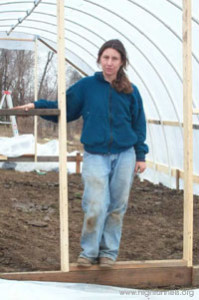
Katherine Kelly in her newly constructed hoop house.
Robbins and Jim Hail own and operate Bear Creek Farm in Osceola, Missouri.
Katherine Kelly owns and operates Full Circle Farm in Kansas City, Kansas.
Ted Carey, Extension Specialist Food Crops, Kansas State Research and Extension Center Olathe, Kansas.




